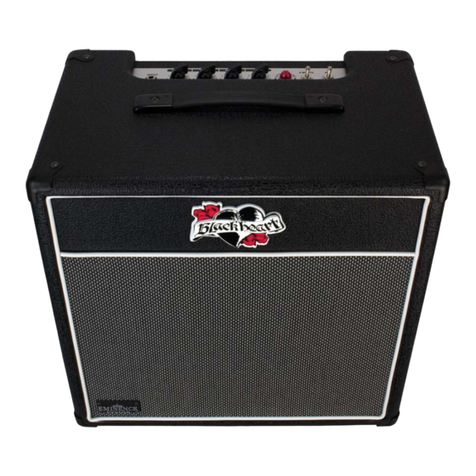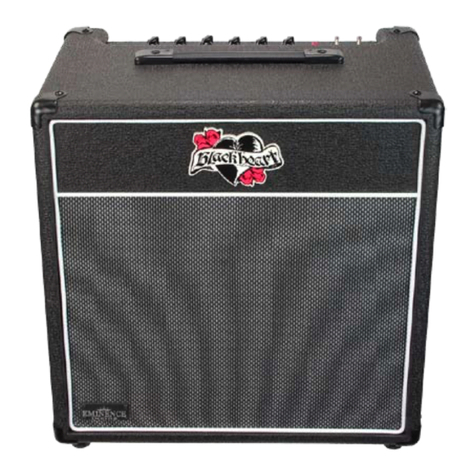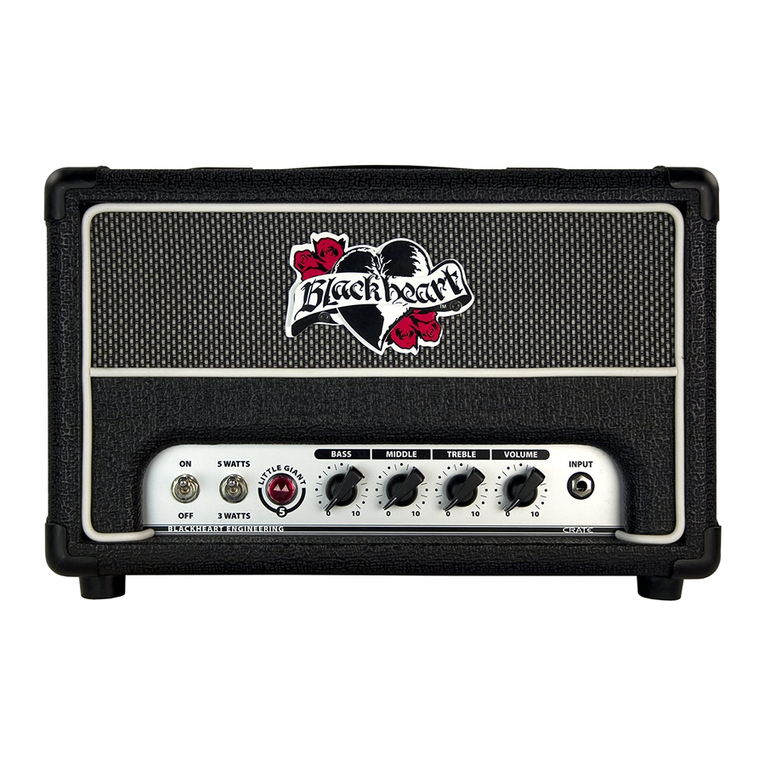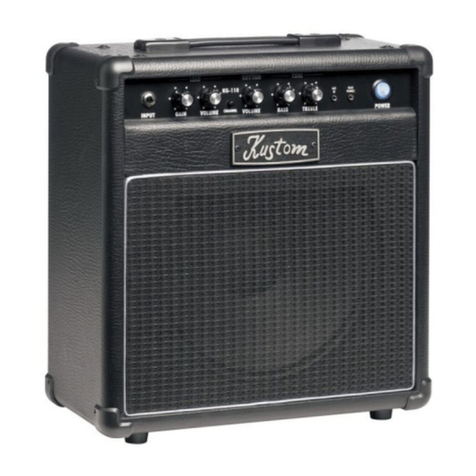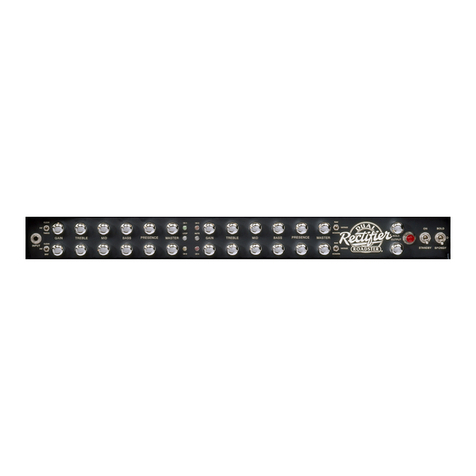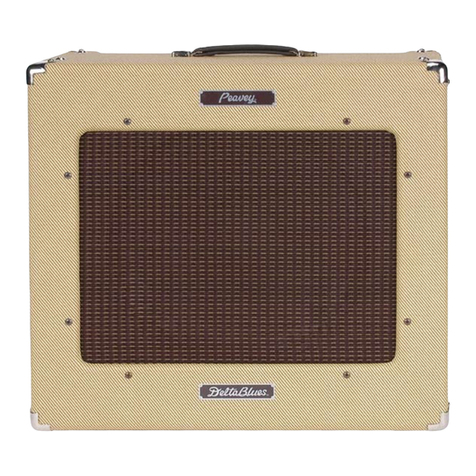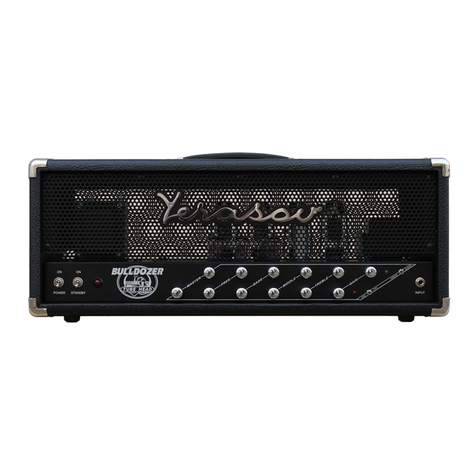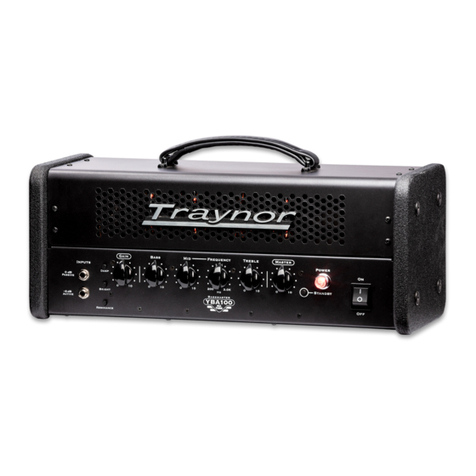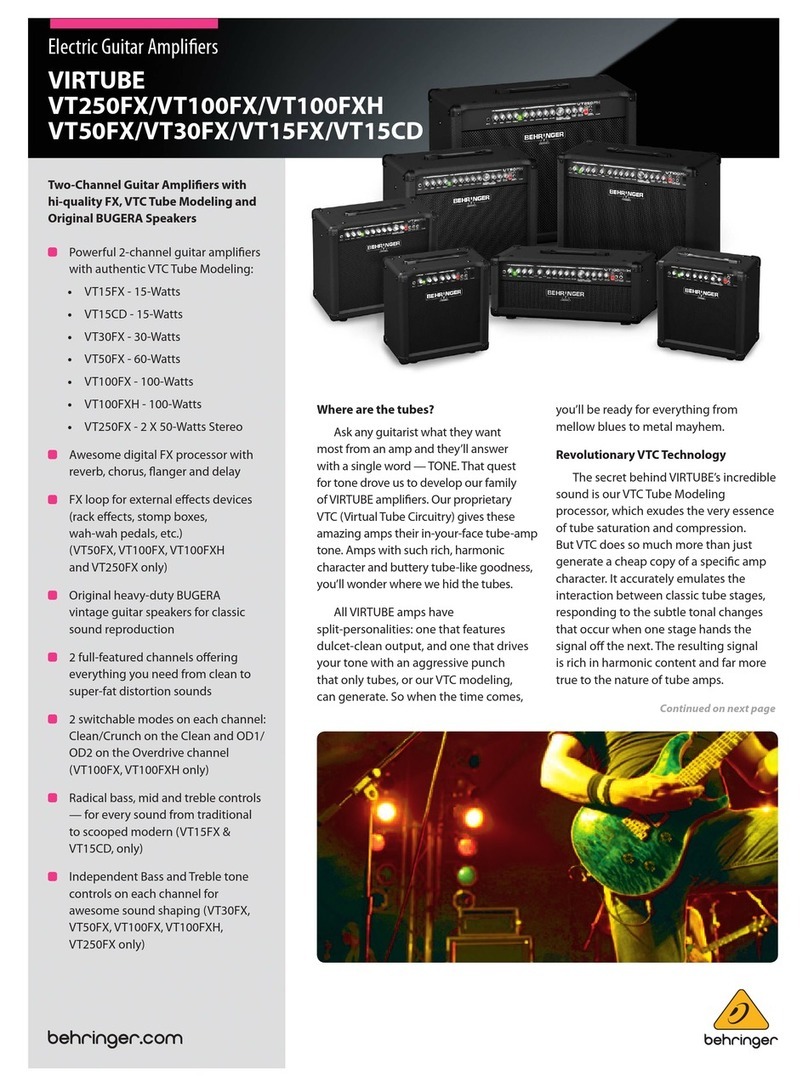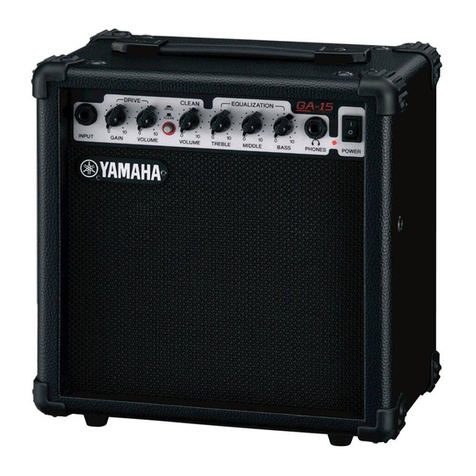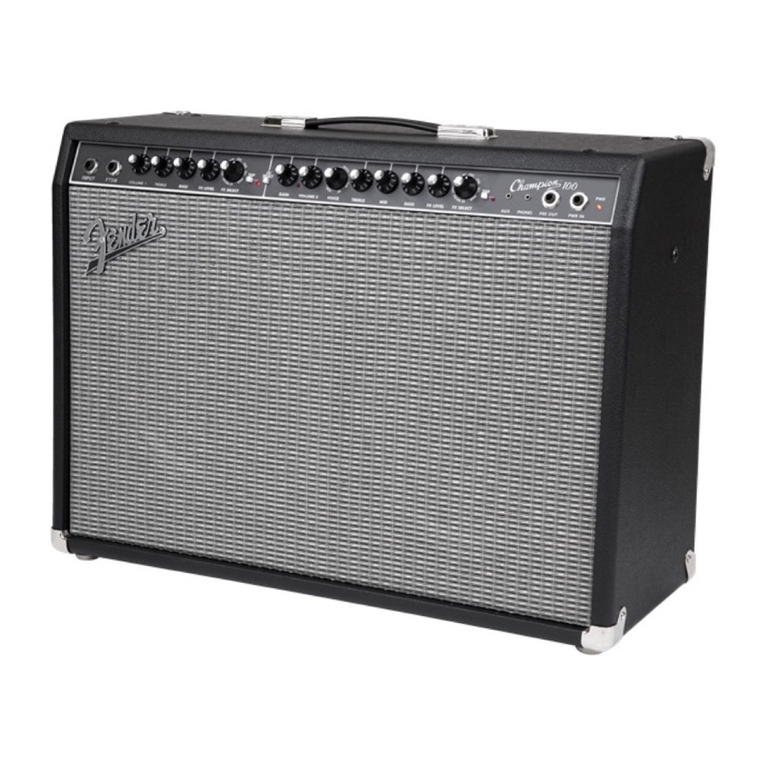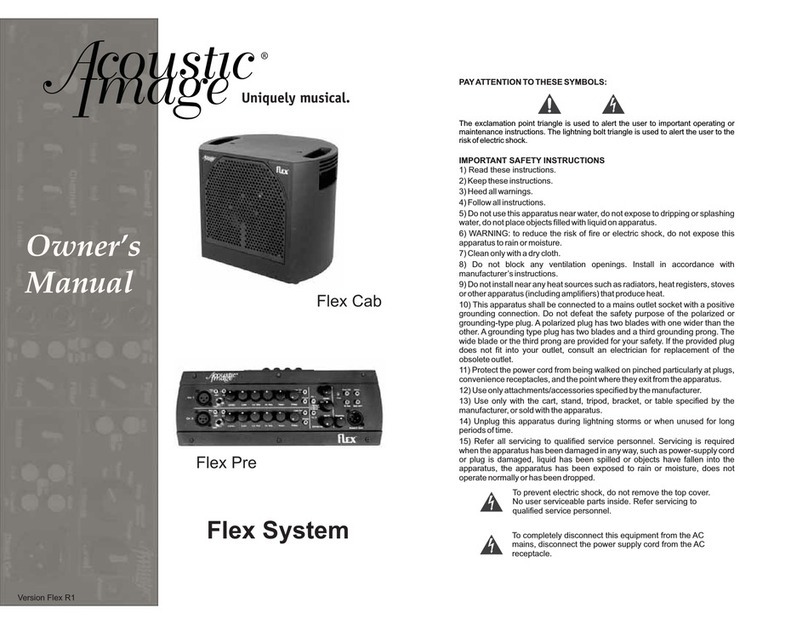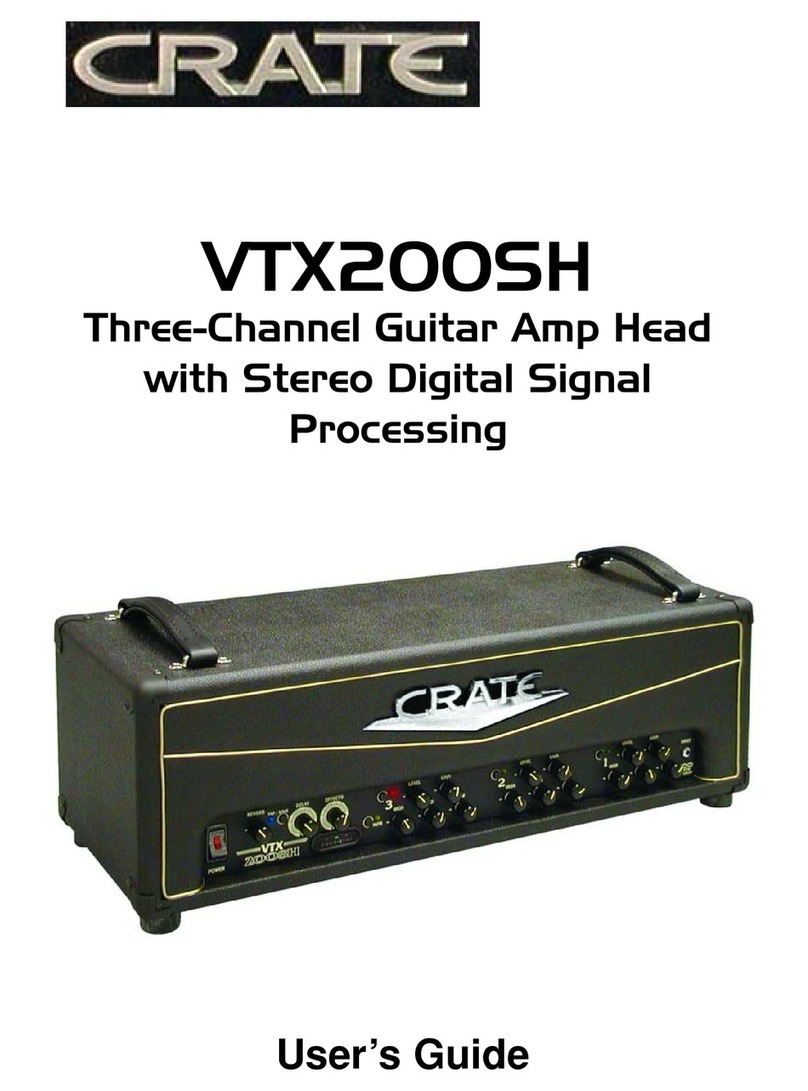Blackheart BH15H Handsome Devil User manual

BH15H Handsome Devil
Guitar Amplifier Head
User’s Guide

2
TABLE OF CONTENTS
Introduction ..........................................................................3
BH15H Special Features........................................................4
The Front Panel ....................................................................5
The Rear Panel .....................................................................6
Important Information About Tubes and Tube Products ............8
System Block Diagram........................................................11
Technical Specifications.......................................................12
PORTABLE CART
WARNING
1. Read these instructions.
2. Keep these instructions.
3. Heed all warnings.
4. Follow all instructions.
5. Do not use this apparatus near water.
6. Clean only with a dry cloth.
7. Do not block any ventilation openings. Install in
accordance with the manufacturer’s instructions.
8. Do not install near any heat sources such as
radiators, heat registers, stoves, or other appara-
tus (including amplifiers) that produce heat.
9. Do not defeat the safety purpose of the polar-
ized or grounding-type plug. A polarized plug
has two blades with one wider than the other. A
grounding-type plug has two blades and a third
grounding prong. The wide blade or the third
prong are provided for your safety. If the provided
plug does not fit into your outlet, consult an elec-
trician for replacement of the obsolete outlet.
10.
Protect the power cord from being walked
on or pinched particularly at plugs, convenience
receptacles, and the point where they exit from
the apparatus.
11.
Only use attachments/accessories specified
by the manufacturer.
12.
Use only with a cart, stand,
tripod, bracket, or table specified
by the manufacturer, or sold with
the apparatus. When a cart is
used, use caution when moving
the cart/apparatus combination to
avoid injury from tip-over.
13.
Unplug this apparatus during lightning storms
or when unused for long periods of time.
IMPORTANT SAFETY INSTRUCTIONS
14.
Refer all servicing to qualified service person-
nel. Servicing is required when the apparatus has
been damaged in any way, such as power-supply
cord or plug is damaged, liquid has been spilled
or objects have fallen into the apparatus, the
apparatus has been exposed to rain or moisture,
does not operate normally, or has been dropped.
15.
Do not overload wall outlets and extension
cords as this can result in a risk of fire or electric
shock.
16.
This apparatus shall not be exposed to drip-
ping or splashing, and no object filled with liquids,
such as vases or beer glasses, shall be placed on
the apparatus.
17.
This apparatus has been designed with Class-I
construction and must be connected to a mains
socket outlet with a protective earthing connection
(the third grounding prong).
18.
This apparatus has been equipped with an all-
pole mains switch. This switch is located on the
front panel and should remain readily accessible
to the user.
CAUTION AVIS
RISK OF ELECTRIC SHOCK. DO NOT OPEN
RISQUE DE CHOC ELECTRIQUE. NE PAS OUVRIR
CAUTION: TO REDUCE THE RISK OF ELECTRIC SHOCK DO NOT REMOVE COVER (OR BACK)
NO USER-SERVICEABLE PARTS INSIDE. REFER SERVICING TO QUALIFIED PERSONNEL
ATTENTION: POUR EVITER LES RISQUES DE CHOC ELECTRIQUE, NE PAS ENLEVER LE COUVERCLE.
AUCUN ENTRETIEN DE PIECES INTERIEURES PAR L'USAGER.
CONFIER L'ENTRETIEN AU PERSONNEL QUALIFIE.
AVIS: POUR EVITER LES RISQUES D'INCENDIE OU D'ELECTROCUTION, N'EXPOSEZ PAS CET ARTICLE
A LA PLUIE OU A L'HUMIDITE
The lightning flash with arrowhead symbol within an equilateral triangle is
intended to alert the user to the presence of uninsulated "dangerous
voltage" within the product's enclosure, that may be of sufficient magnitude
to constitute a risk of electric shock to persons.
Le symbole éclair avec point de flèche à l'intérieur d'un triangle équilatéral
est utilisé pour alerter l'utilisateur de la présence à l'intérieur du coffret de
"voltage dangereux" non isolé d'ampleur suffisante pour constituer un risque
d'éléctrocution.
The exclamation point within an equilateral triangle is intended to alert the
user of the presence of important operating and maintenance (servicing)
instructions in the literature accompanying the appliance.
Le point d'exclamation à l'intérieur d'un triangle équilatéral est employé
pour alerter les utilisateurs de la présence d'instructions importantes pour le
fonctionnement et l'entretien (service) dans le livret d'instruction
accompagnant l'appareil.

3
Introduction
Congratulations!
You have just purchased what we believe to be one of the most significant objects that you’ll acquire in your life-
time—a tube amp. If that’s not enough, you’ve gone and gotten yourself a Blackheart Engineering tube amp. So let’s take a big picture view
of this for a second: You’re a guitar player who could have bought anything to bring your mind-bending chops to life, to unleash upon the
masses the wrath of your otherworldly, mad riffin’ skills. Did you settle? No, because you’re more than just “whatever.” You’re like, “hear me
roar!” so you go tube. Not “hybrid,” not “solid state,” but all tube—from when you scream “jump!” until your speaker wails “how high sir!”
We like the way you do your hair. You’ve got style. Speaking of which, take a look at the way this amp is built. 16 gauge steel, ½" radius
corners in a void-free birch ply cabinet that looks like Michelangelo covered it for you personally. How about a double-sided PCB with 2 ounce
copper traces, so your big fat sound has lots to hold on to traveling through a classic boutique circuit path designed by none other than
Pyotr Belov himself. The guy’s got a soldering iron in his hands most hours of the night so if he says “make the thing like a tank,” everyone
agrees real quickly. Who knows, you might be in some sort of edge band; knock the thing around a bit. That’s a Blackheart thing. We make
rock-solid, no compromise music gear that sounds like choruses of angels singing big, beefy power chords. We work with glass, metal
and wood just like the powers that be intended when they created rock and roll. We take every amp personally and we do it assuming you
worked hard to get it and we’re not letting you down. That fancy tattoo logo was inspired by one of our test animals.* He said a great amp
leaves a permanent mark on your tone, and shapes how you play, write, perform, etc. So, when you laid down coin for a Blackheart, you
kind of got hitched.
And it didn’t set you back much, especially when you consider what you got. Every Blackheart design starts as a hand-built masterpiece
with no thoughts about cutting cost or going for it on the cheap. Pyotr picks every component one by one and tweaks until his ears hear
the tone. Once he’s given birth to the prototype (ouch!), he personally works with offshore manufacturing to translate that exact tone into the
most affordable piece of gear that won’t let you down. Literally, he works in the factory, training other people how to build boutique-quality
amps and sits on the QC line before anything gets into a box. Blackheart isn’t the cheapest—plenty of other amps are cheap and you can
have your pick. We prefer to be ultra-high quality and performance for a price that anyone can afford.
So thanks for laying down your hard earned cash for a Blackheart Engineering product. We’re not going to disappoint you. You’ve got, in
your hands, one of the best sounding, best quality, old school inspired amps that’s ever been made.
Vous avez notre coeur,
Blackheart Engineering
* We don’t test on little furry helpless animals of course. We call our artists animals because, well, we’ve eaten with them. They give their
time and opinions to us on a regular basis and have a lot to do with how good your Blackheart is.
CONSIGNES DE SECURITE IMPORTANTES
- LIRE, SUIVRE TOUTES LES INSTRUCTIONS ET LES PRECAUTIONS D’UTILISATION
- NE PAS UTILISER PROCHE D’UNE SOURCE DE CHALEUR ET NE PAS BLOQUER OU OBSTRUER LE SYSTEME DE VENTILATION SUR CET APPAREIL. POUR UNE
UTILISATION CONFORME, CET APPAREIL NECESSITE ENVIRON 7CM D’ESPACE BIEN VENTILE AUTOUR DE SON SYSTEME DE REFROIDISSEMENT, AINSI QU’UN COURANT
D’AIR FRAIS CONSTANT
- NE PAS UTILISER CET APPAREIL PROCHE D’UNE SOURCE LIQUIDE
- NETTOYER SEULEMENT A L’AIDE D’UN CHIFFON DOUX ET SEC ET NE PAS UTILISER DE PRODUITS MENAGERS
- CONNECTER UNIQUEMENT LE CABLE D’ALIMENTATION FOURNI SUR UNE PRISE AVEC MISE A LA TERRE, ET COMPATIBLE AVEC LA TENSION, L’INTENSITE ET LA
FREQUENCE REQUISES INDIQUEES SUR LA FACE ARRIERE DE L’APPAREIL
- S’ASSURER DE NE PAS MARCHER, PLIER OU TIRER SUR LE CABLE D’ALIMENTATION
- DEBRANCHER L’APPAREIL LORS D’UNE TEMPETE OU LORS D’UNE TRES LONGUE PERIODE DE NON UTILISATION
- UTILISER UNIQUEMENT DES ACCESSOIRES SPECIFIES PAR LE FABRICANT POUR UNE UTILISATION EN TOUTE SECURITE ET POUR EVITER DES BLESSURES
- ATTENTION: AFIN DE PREVENIR TOUT RISQUE DE CHOCS ELECTRIQUES OU DE DEBUT D’INCENDIE, NE PAS EXPOSER CET APPAREIL A LA PLUIE ET A L’HUMIDITE
- TOUT ENTRETIEN DOIT ETRE FAIT PAR UN TECHNICIEN QUALIFIE
- NOS AMPLIFICATEURS PEUVENT PRODUIRE DE TRES HAUTES PRESSIONS ACOUSTIQUES QUI PEUVENT CAUSER DES DOMMAGES AUDITIFS PERMANENTS OU
DEFINITIFS. L’UTILISER AVEC UNE GRANDE PRECAUTION EST CONSEILLE ET DES PROTECTIONS AUDITIVES SONT RECOMMANDEES POUR UNE UTILISATION A FORT
VOLUME.
- ATTENTION: CET APPAREIL REQUIERT UNE PRISE MURALE AVEC MISE A LA TERRE, AUX NORMES ACTUELLES ET COMPATIBLE AVEC LES SPECIFICATIONS
ELECTRIQUES SE TROUVANT EN FACE ARRIERE DE L’APPAREIL. LA PRISE ELECTRIQUE DOIT RESTER ACCESSIBLE POUR DEBRANCHER L’APPAREIL EN CAS DE DEFAUT
PENDANT L’UTILISATION
- CET APPAREIL DOIT ETRE DEBRANCHE SI IL N’EST PAS UTILISE
Elimination correcte du produit : Ce symbole indique que ce produit ne doit pas être éliminé avec les ordures ménagères, comme le prévoiT la directive WEEE (2002/96/
EC) et votre loi nationale.
Ce produit doit être remis à un site de recyclage des déchets électriques et des équipements électroniques (EEE).
Un mauvais recyclage de ce type de déchet peut avoir de possibles impacts négatifs sur l’environnement et la santé humaine dus aux émanations de substances.
Dans un même temps, votre coopération à un recyclage correct de ce produit contribuera à la bonne utilisation des ressources naturelles.
Pour connaître l’endroit où il est possible de recycler ces équipements, merci de contacter votre mairie, les services de recyclages ou le service des déchets ménagers.

4
BH15H Special Features:
• Push-Pull Class A circuit
• All tube signal path
• Two 12AX7/ECC83 dual-triode preamp tubes and two EL84/6BQ5 pentode output tubes
• Pentode (15W RMS) Triode (7W RMS) switch
• DC filament power supply for preamp tubes
• 3-band EQ, Level (Master Volume) Control and Presence Control
• 16-gauge (1.5 mm) thick, folded and spot welded steel chassis
• Double-sided custom color PCB with 2 oz. copper
• 15-ply, 18 mm thick, void-free birch plywood construction
• 16 ohm, two 8 ohm, and two 4 ohm speaker outputs
• Kicks sound in the faces of all those who have wronged you

5
The Front Panel
1. ON/OFF SWITCH: Use this switch to
turn the amplifier on and off.
2. 15 WATTS/7 WATTS: This is the
Pentode/Triode switch. It allows you
to operate the amplifier in two distinct
modes of operation and output power
rating. The Pentode is the aggressive
setting that gives you full output power
of 15 watts RMS. The Triode is a gen-
tler setting with more head room that
reduces the output power to 7 watts
RMS.
3. INDICATOR LAMP: This illuminates
when the amplifier is turned on (power,
that is).
4. PRESENCE: Use this to boost the high
frequency response and overall punch
of the output section. The adjustment
range is +28dB at 20 kHz.
5. BASS: Use this to adjust the output
level of the low frequencies. The adjust-
ment range is +10 dB at 100 Hz.
6. MIDDLE: Use this to adjust the output
level of the mid frequencies. The adjust-
ment range is +6 dB at 1 kHz.
7. TREBLE: Use this to adjust the output
level of the high frequencies. The adjust-
ment range is +14 dB at 10 kHz.
8. LEVEL: Use this to adjust output vol-
ume of the amplifier.
9. DRIVE: Use this to adjust the amp gain
of the amplifier
10. INPUT: Use this jack to connect your
guitar to the amplifier using a high-qual-
ity shielded instrument cable.
PRESENCE
15 WATTSON
7 WATTSOFF
BASS MIDDLE TREBLE LEVEL DRIVE
INPUT
H
A
N
D
S
O
M
E
D
E
V
I
L
0 10 0 10 0 10 0 10 0 10 0 10
15
BH15H
3 4 5 6 7 8 9 101 2

6
The Rear Panel
LOUDSPEAKER OUTPUTS
POWER OUTPUT 15 WATTS RMS
CONNECT SPEAKERS BEFORE USE
4 OHMS 4 OHMS 8 OHMS 8 OHMS 16 OHMS
HANDSOME DEVIL 15 - PUSH PULL/CLASS A AMPLIFIER
10 912 11
The rear panel has connections for the AC
power cord and external speaker cabinets.
WARNING! Never turn on or use the ampli-
fier without a load or speaker connected to
the amplifier.
9. AC Power Input with Mains Fuse:
The amplifier is equipped with a detach-
able power cord that plugs into this
IEC Mains socket. The AC power cord
should only be plugged into a grounded
power outlet that meets all applicable
electrical codes and is compatible
with the voltage, power, and frequency
requirements stated on the rear panel
of the amplifier. Do not attempt to
defeat the safety ground connection.
The AC Mains fuse is located in the IEC
Mains socket and is used to protect
the amplifier from electrical faults. If
the fuse needs to be replaced, please
refer to the correct fuse specifications
located on the back panel of the ampli-
fier. Always unplug the power cord
when changing or inspecting the fuse.
Never bypass the fuse or replace it with
a wrong type or value.
10. 16 OHMS: This output can power an
external speaker cabinet rated at 16
ohms (see top-left figure on next page).
11. 8 OHMS: The two 8 ohms speaker out-
put jacks are wired in parallel. See the
connection examples on the next page.
12. 4 OHMS: The two 4 ohms speaker out-
put jacks are wired in parallel. See the
connection examples on the next page.
Connecting speaker cabinets
The hookup diagrams on the next page
show some different cabinets, their imped-
ance, where to plug them in, and the total
load impedance placed on the amplifier.
ALWAYS use good quality (non-shielded)
speaker cable to connect speaker cabinets.
Never use (shielded) instrument cable.
ALWAYS match the amplifier’s speaker
output impedance to the impedance of the
speaker that is being used.
• Use only one type of impedance output
at a time.
• If more than one speaker is connected
at the same time, make sure they all
have the same impedance rating.
• Never use two or more cabinets with
different impedance ratings. This will
create an unbalanced load.
• When using multiple speaker cabinets
(with the same impedance rating),
match the total load impedance of the
speaker cabinets to the speaker output
of the amplifier.
For equal-impedance speakers connected in
parallel, the first law of rock and roll states:
SPEAKER CABINET IMPEDANCE divided by
NUMBER OF CABINETS = TOTAL LOAD

7
Typical connections to speaker cabinets
4 OHMS 4 OHMS 8 OHMS 8 OHMS 16 OHMS
4 OHMS 4 OHMS 8 OHMS 8 OHMS 16 OHMS
4 OHMS 4 OHMS 8 OHMS 8 OHMS 16 OHMS
4 OHMS 4 OHMS 8 OHMS 8 OHMS 16 OHMS
4 OHMS 4 OHMS 8 OHMS 8 OHMS 16 OHMS
4 OHMS 4 OHMS 8 OHMS 8 OHMS 16 OHMS
4 OHMS 4 OHMS 8 OHMS 8 OHMS 16 OHMS
4 OHMS 4 OHMS 8 OHMS 8 OHMS 16 OHMS
16Ω16Ω
8Ω16Ω16Ω
8Ω8Ω
8Ω8Ω
Two 16 ohm cabinets. Total Load = 8 ohm
Use one 8 ohm output jack.
One 8 ohm cabinet. Total Load = 8 ohm
Use an 8 ohm output jack.
Four 16 ohm cabinets in parallel.
Total Load = 4 ohm. Use a 4 ohm output jack.
(This is a possible system, but unlikely. It was
thrown in while we were on a theoretical roll)
Two 16 ohm cabinets. Total Load = 8 ohm
Use both 8 ohm output jacks.
Two 8 ohm cabinets. Total Load = 4 ohm
Use one 4 ohm output jack.
Two 8 ohm cabinets. Total Load = 4 ohm
Use both 4 ohm output jacks.
Speaker
Cabinets
in parallel
Speaker
Cabinets
One 16 ohm cabinet. Total Load = 16 ohm
Use the 16 ohm output jack.
16Ω
Speaker
Cabinet
4Ω
One 4 ohm cabinet. Total Load = 4 ohm
Use a 4 ohm output jack.
Speaker
Cabinets
in parallel
Speaker
Cabinets
Speaker
Cabinet
Speaker
Cabinet
16Ω16Ω16Ω16Ω

8
The Nature Of Tubes — Why (And When) To Replace Them:
Tubes are made up of a number of fragile mechanical components that are vacuum-sealed in a
glass envelope or bubble. The tube’s longevity is based on a number of factors which include
how hard and often the amplifier is played, vibration from the speakers, road travel, repeated
set up and tear down, etc.
Any time you notice a change in your amplifier’s performance, check the tubes first.
If it’s been a while since the tubes were replaced and the sound from your amplifier lacks
punch, fades in and out, loses highs or lows or produces unusual sounds, the power tubes
probably need to be replaced. If your amplifier squeals, makes noise, loses gain, starts to
hum, lacks “sensitivity”, or feels as if it is working against you, the preamplifier tubes may
need to be replaced.
The power tubes are subjected to considerably more stress than the preamplifier tubes.
Consequently, they almost always fail/degrade first. If deteriorating power tubes aren’t
replaced they will ultimately fail. Depending on the failure mode, they may even cause severe
damage to the audio output transformer and/or other components in the amplifier. Replacing
the tubes before they fail completely has the potential to save you time, money and unwanted
trouble. Since power tubes work together in an amplifier, it is crucial that they (if there is more
than one) be replaced by a matched set. If you’re on the road a lot, we recommend that you
carry a spare matched set of replacement power tubes and their associated driver tubes.
After turning off the power and disconnecting the amplifier from the power source, carefully
check the tubes (in bright light) for cracks or white spots inside the glass or any other appar-
ent damage. Then, with the power on, view the tubes in a dark room. Look for preamplifier
tubes that do not glow at all or power tubes that glow excessively red.
Whenever you replace the power tube(s):
• Always have the amplifier’s bias voltage checked by a qualified service center. Improper
bias voltage will cause degradation in performance and possibly damage the tubes and/or
the amplifier. (See “The Importance of Proper Biasing”, below for more information).
• We highly recommend that you replace the driver tube(s) as well. The driver tube deter-
mines the shape and amplitude of the signal applied to the power tube(s) and has to work
almost as hard as the power tube(s).
You can check your preamplifier tubes for microphonics by turning the amplifier on, turning up
the gain and tapping lightly on each tube with the end of a pencil or a chop stick (my favorite).
You will be able to hear the tapping through your speakers, which is normal. It is not normal
for a tube to ring like a bell after it’s tapped. If it does ring then it’s microphonic and should be
replaced. Remember to use only high quality, low microphonic tubes in the preamplifier section.
Even though power tubes are rarely microphonic, you should check them anyway. The power
tubes can be checked for microphonics just like pre-amp tubes.
In the case of very high gain amps, you may be able to reduce the amount of noise generated
by simply swapping the preamp tubes around.
Important Information about Tubes and Tube Products:

9
The Importance Of Proper Biasing:
For the best performance and longest tube life, proper biasing is imperative. Bias is the nega-
tive voltage which is applied to the power tube’s control grid to set the level of idle current.
We cannot over emphasize the difference in warmth of tone and dynamic response that come
with proper biasing. If the bias is set too high (over biased), the sound from the amp will be
distorted at all levels. If the bias is set too low, (under biased) the power tubes will run hot (the
plates inside the tubes may glow red due to excessive heat) and the sound from the amplifier
will lack power and punch. The excessive heat greatly reduces tube life – from a few days to
as little as a few hours in extreme cases. Setting the bias on your amp is like setting the idle
on your car. If it’s too high or hot it’s running away with you and if it’s too low or cold it will
choke when you step on it.
The bias is adjusted at the factory in accordance with the type of power tube(s) installed in
your amplifier. It is important to point out that tubes of the same type and specification typi-
cally exhibit different performance characteristics. Consequently, whenever power tubes are
replaced, the bias voltage must be checked (unless the amplifier is equipped with “self-biasing”
circuitry) and readjusted to accommodate the operating parameters of the replacement tubes.
Depending on the model and amplifier type, there may be hum balance controls, trim pots, or
bias adjustment controls on its rear panel. However, the bias adjustment should be performed
only by qualified service personnel with the proper, calibrated test equipment.
Important Information About Tubes and Tube Products (continued):

10
Survival Tips For Tube Amplifiers:
To prolong tube life, observe these tips and recommendations:
• Match the impedance of your speaker cabinet(s) to your amplifier. Improper impedance
matching will contribute to early tube degradation and may cause premature tube failure.
• Make sure the speaker(s) are properly connected prior to turning on the amplifier.
• After playing the amplifier, allow sufficient time for it to properly cool down prior to moving
it. A properly cooled amplifier prolongs tube life due to the internal components being less
susceptible to the damage caused by vibration.
• Allow the amplifier to warm up to room temperature before turning it on. The heat gener-
ated by the tube elements can crack a cold glass housing.
• Replace the output tube(s) before the performance degrades or the tubes fail completely.
Replace the tube(s) on a regular basis (at least once per year or as often as every 4 to 6
months if you play long and hard every day).
• Always have the bias checked after replacing the output tubes (unless the amplifier is
equipped with “self-biasing circuitry”). This should be done ONLY at a qualified service
center. Improper biasing could result in the tubes running too hot, which greatly reduces
the life of the tubes – or too cold, which results in distorted sound regardless of level
settings. Do not play the amplifier if it exhibits these symptoms – get the bias checked/
adjusted immediately to prevent tube failure and/or other damage.
• If the locating notch on the base of a power tube breaks off, replace the tube. This signifi-
cantly reduces the risk of damaging your amplifier by incorrectly inserting the tube.
• Protect the amplifier from dust and moisture. If liquid gets into the amplifier proper, or
if the amplifier is dropped or otherwise mechanically abused, have it checked out at an
authorized service center before using it.
• Proper maintenance and cleaning in combination with routine checkups by your authorized
service center will insure the best performance and longest life from your amplifier.
CAUTION: Tube replacement should be performed only by qualified service personnel
who are familiar with the dangers of hazardous voltages that are typically present in
tube circuitry.
Important Information About Tubes and Tube Products (continued):

11
System Block Diagram
16 OHM
SPEAKER
OUTPUTS
8 OHM
8 OHM
4 OHM
4 OHM
MIDDLE BASSTREBLE
INPUT
DRIVE LEVEL
PRESENCE
B+
PENTODE–TRIODE
15 WATT–7 WATT
SWITCH
NOTE: This equipment has been tested and found to comply
with the limits for a Class B digital device, pursuant to part 15 of
the FCC Rules. These limits are designed to provide reasonable
protection against harmful interference in a residential installation.
This equipment generates, uses, and can radiate radio frequency
energy and, if not installed and used in accordance with the instruc-
tions, may cause harmful interference to radio communications.
However, there is no guarantee that interference will not occur in a
particular installation. If this equipment does cause harmful interfer-
ence to radio or television reception, which can be determined by
turning the equipment off and on, the user is encouraged to try to
correct the interference by one or more of the following measures:
• Reorient or relocate the receiving antenna.
• Increase the separation between the equipment and the
receiver.
• Connect the equipment into an outlet on a circuit different
from that to which the receiver is connected.
• Consult the dealer or an experienced radio/TV technician for
help.
CAUTION: Changes or modifications to this device not expressly
approved by LOUD Technologies Inc. could void the user's authority
to operate the equipment under FCC rules.
This apparatus does not exceed the Class A/Class B (whichever
is applicable)
limits for radio noise emissions from digital appara-
tus as
set out in the radio interference regulations of the Canadian
Department
of Communications.
Duration,
per day in
hours
Sound Level
dBA, Slow
Response
Typical Example
8 90 Duo in small club
6 92
4 95 Subway Train
3 97
2 100 Very loud classical music
1.5 102
1 105 Pyotr screaming at Zane and Troy
about deadlines
0.5 110
0.25 or less 115 Loudest parts at a rock concert
ATTENTION — Le présent appareil numérique n’émet pas de
bruits radioélectriques dépassant las limites applicables aux appa-
reils numériques de class A/de class B (selon le cas) prescrites
dans le réglement sur le brouillage radioélectrique édicté par les
ministere des communications du Canada.
Exposure to extremely high noise levels may cause permanent
hearing loss. Individuals vary considerably in susceptibility to noise-
induced hearing loss, but nearly everyone will lose some hearing
if exposed to sufficiently intense noise for a period of time. The
U.S. Government’s Occupational Safety and Health Administration
(OSHA) has specified the permissible noise level exposures shown
in the following chart.
According to OSHA, any exposure in excess of these per-
missible limits could result in some hearing loss. To ensure against
potentially dangerous exposure to high sound pressure levels, it is
recommended that all persons exposed to equipment capable of
producing high sound pressure levels use hearing protectors while
the equipment is in operation. Ear plugs or protectors in the ear
canals or over the ears must be worn when operating the equip-
ment in order to prevent permanent hearing loss if exposure is in
excess of the limits set forth here:

12
BH15H TECHNICAL SPECIFICATIONS
Output Power Rating Pentode: 15 W rms @ 12.3% THD, 16 ohm load
Triode: 7 W rms @ 9% THD, 16 ohm load
Signal-to-Noise Ratio 63 dB, Typical
Input Impedance 1 Meg Ohm
EQ Treble: 14 dB range @ 10 kHz
Middle: 6 dB range @ 1 kHz
Bass: 10 dB range @ 100 Hz
Presence: 10.2 dB range @ 100 Hz
28 dB range @ 20 kHz
Preamp Tubes 2 x 12AX7/ECC83
Power Tubes 2 x EL84/6BQ5
Rectifier Solid State
Speaker Outputs 1 x 16 ohms
2 x 8 ohms (8 ohms total load impedance)
2 x 4 ohms (4 ohms total load impedance)
Power Requirements 110/120 VAC, 50/60 Hz, 90 W
220/240 VAC, 50/60 Hz, 90 W
AC Mains Fuse 100/120 VAC: T2.AL 250V Fuse
220/240 VAC: T1.AL 250V Fuse
Size (H x W x D) 9.6 in/243 mm (including feet) x
18.0 in/460 mm x 9.0 in/228 mm
Weight 28.6 lb/13 kg
The Blackheart BH15H Handsome Devil is covered with a durable fabric-backed vinyl material. Wipe
it clean with a lint-free cloth. Never spray cleaning agents onto the cabinet. Avoid abrasive cleansers
which would damage the finish.
Blackheart continually develops new products, as well as improves existing ones. For this reason, the specifica-
tions and information in this manual are subject to change without notice.
“Blackheart” is a registered trademark of LOUD Technologies Inc. All other brand names mentioned are trade-
marks or registered trademarks of their respective holders and are hereby acknowledged.
Service Information
If you are having a problem with your Blackheart BH15H Handsome Devil, you can go to our website (www.blackhearteng.com) and click on
“Heart Surgery” for service information, or call 1-800-898-3211 Monday-Friday, during normal business hours, Pacific Time, to explain the prob-
lem. If you are outside of the U.S., contact your local distributor for technical support and service.
Correct disposal of this product: This symbol indicates that this product should not be disposed of with your household waste,
according to the WEEE directive (2002/96/EC) and your national law. This product should be handed over to an authorized col-
lection site for recycling waste electrical and electronic equipment (EEE). Improper handling of this type of waste could have a
possible negative impact on the environment and human health due to potentially hazardous substances that are generally asso-
ciated with EEE. At the same time, your cooperation in the correct disposal of this product will contribute to the effective usage
of natural resources. For more information about where you can drop off your waste equipment for recycling, please contact your
local city office, waste authority, or your household waste disposal service.
BLACKHEART ENGINEERING
AMPLIFIER SERIES
www.blackhearteng.com
@2009 LOUD Technologies Inc.
16220 Wood-Red Road NE • Woodinville, WA 98072
Part No. SW0754 Rev. C 04/09
Table of contents
Other Blackheart Musical Instrument Amplifier manuals

